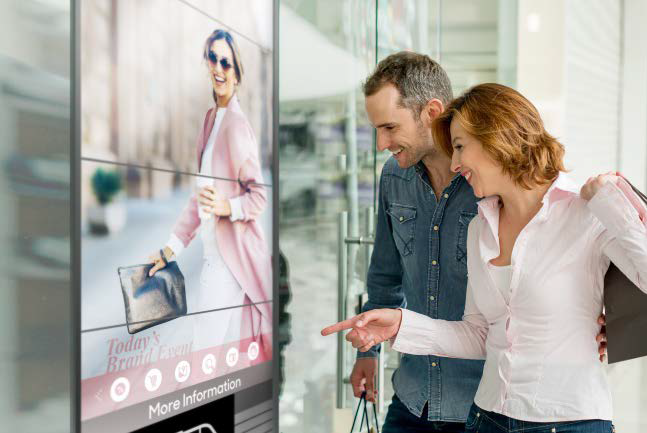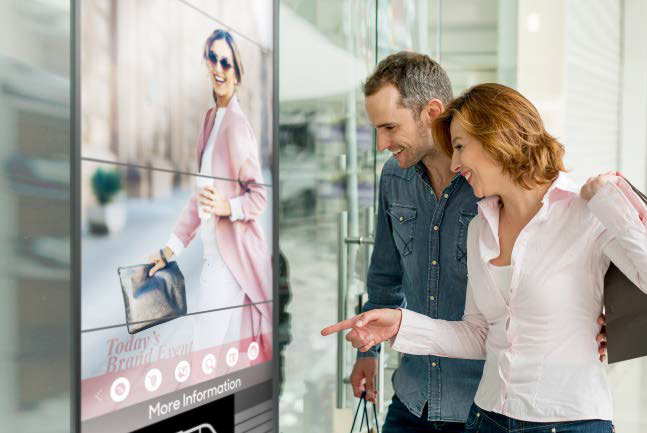
There are many things consumers have long disliked about shopping, from poorly lit dressing rooms to lack of information to pushy salespeople. Digital and mobile technologies have started to chip away at those irritants, but it turns out those are just the beginning. With digital signage now the norm and the mobile revolution well underway, augmented reality (AR) and virtual reality (VR) are set to completely transform the shopping experience, replacing the pain points with captivating, interactive experiences that both inform and entertain.
Goldman Sachs forecasts the market for AR and VR in retail will reach $1.6 billion by 2025. VR is proving a great fit for use cases where the retailer wants to put the consumer into a completely new environment, like behind the wheel of a car, while AR layers images over the consumer’s immediate surroundings, such as projecting a new outfit on an image of the shopper standing in the store.
Alongside these retail technology trends, retailers are also investing in artificial intelligence (AI) and the Internet of Things (IoT). In fact, many of the use cases making the most impact on the customer experience combine some or all of these technologies to create a more engaging encounter with the brand. These retailers are betting on a data-fueled, differentiated experience to boost conversions and revenue by making shopping fun again.
How AR and VR in Retail Improve Shopper Experience
Here are some examples of how retailers are already leveraging these technologies to do away with the things shoppers can’t stand, and replace them with better experiences.
Creating Virtual Encounters: AR or VR can help overcome the hassle factor of shopping. Here’s one example: according to a McKinsey study, the average car buyer today visits 1.6 auto dealerships, down from five dealerships 10 years ago. Many call the experience boring, confrontational and bureaucratic, according to The Economist. But given how complicated cars are becoming, customers also want a knowledgeable person to talk them through all the features like entertainment systems, navigation services and automated parking. VR can bridge consumers’ seeming conflict between the desire for personal service and unwillingness to visit a store by enabling experiences virtually. For a car purchase, this might mean exploring the cockpit or taking a virtual test drive.
Testing or Trying on Merchandise: AR and VR can both be useful in helping consumers see products in context, such as a furniture buyer previewing how a couch would look in their living room. To overcome the stumbling block of consumers avoiding the possibility of overheated, poorly lit fitting rooms, Timberland unveiled a virtual fitting room using Kinect and digital signage technology that enables passersby to virtually try on every piece of clothing available in the store using hand gestures. Web and Facebook apps use a PC’s built-in cameras and AR to create a similar experience for home users.
Virtual Browsing: Online stores are well-organized, but less compelling and immersive than the experience of moving through a physical store. A VR-generated store lets customers virtually browse the store no matter where they are, and buy items they find — as Karen Miller did with a fashion showroom. Instead of the cost of erecting a brick and mortar location, the retailer simply designs 360-degree panoramas that are accessible on most platforms — including digital signage and smartphones.
Designing Custom Goods: Creating a custom order used to take a lot of time and rely on the customer’s imagination. AR and VR in retail help overcome those hurdles by producing virtual versions of the desired product. Nike’s Makers’ Experience combines AR, object tracking and projection technology (using AI and IoT) as well as digital signage or videowalls to enable a customized design to appear on sneakers. An hour later the customer can pick up the finished product.
Offering Product Info in Context: Lists of specs and features can be dry and mind-numbing. When such information is delivered in context, it makes a bigger impression: the shopper picks up and looks at a product, then sees specific information on the benefits of the part they’re viewing, so it’s much more likely to resonate. For instance, Starbucks is leveraging AR to blend the experiences of shopping in-store and online at its Starbucks Reserve Roastery in Shanghai. Visitors can point their smartphones at a piece of equipment to see how coffee is processed in that machine to produce the product they’re considering.
The Future of AR and VR in Retail
According to Forbes, the future of AR and VR in retail seems to break down into two major use categories. On one hand, AR lends itself well to consumer applications that answer questions such as, “What will it look like in my home? What will it look like on me? Tell me more about how to use this product.” VR, on the other hand, is finding a home in business uses such as store design, shelf assortment and layout, as well as in contextual store walks and real-time store performance, which allow executives to see store data in the context of how the store looks, rather than simply as a chart or list of numbers.
Consumers are excited about shopping’s tech-enabled future. Research by GfK found 38 percent of U.S. consumers hope to see improved experiences in stores, while 35 percent want improved customer service based on individual needs, and another 35 percent seek improved ways to find and compare different products. With their ability to replace the parts shoppers dislike about shopping with a more immersive, interactive and information-fueled experience, AR and VR in retail holds promise to create the differentiated brand experiences that drive conversions, repeat visits and higher revenue.

Lisa Terry is a seasoned B2B writer of articles, blogs, research reports, case studies, white papers and e-books, with a long list of media and corporate clients in hospitality as well as retail, IT and supply chain. She has written for Hospitality Technology, HTNG publications, Nation’s Restaurant News, RIS News, Advertising Age, Consumer Goods Technology, Inbound Logistics, Washington Technology and many others.
- 3 steps to optimizing the car dealership showroom experience
- How to enhance modern dealership operations: Inventory, staffing, and showroom management
- Reducing costs with affordable and resourceful mPOS
- Improving the user experience with mPOS
- Mobile point-of-sale systems: How they streamline the user experience & maximize ROI
- Making inroads into QSR digital transformation
